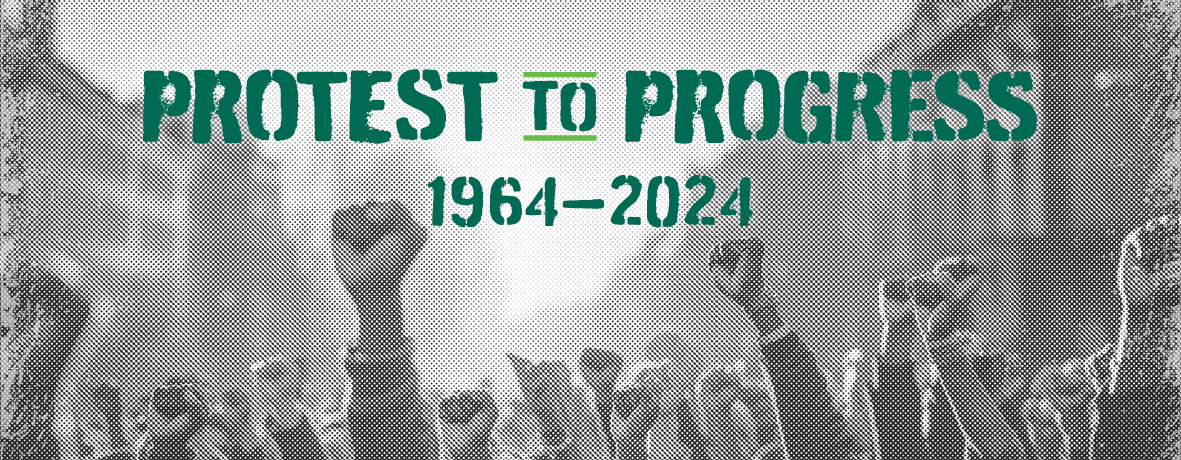Protest to Progress Traces 60 Years of CSU and the Civil Rights Act

View the exhibit online here!
A new exhibit commemorating 60 years of the Civil Rights Act in conjunction with 60 years of Cleveland State University can now be viewed on display in the first-floor atrium of CSU’s Berkman Hall—home to the Jack, Joseph and Morton Mandel Honors College—through Feb. 29.
Protest to Progress reflects the tenor of tragedy and triumph from the 1960s to today. The first influx of Black students at CSU had a profound influence that helped create the diverse, inclusive and welcoming campus it is today.
Ron Kisner, CSU alumnus and founder of The Vindicator, said he hopes the Protest to Progress exhibit will help answer the question, “How did we get here?” through photos, newspaper clippings and commentary.
“The exhibit attempts to connect the history of CSU to events in the city and nation that shaped the University's early and future directions,” he said during the opening reception on Feb. 1. “It also highlights how the University's commitment to diversity, equity and inclusion evolved for it to become an urban university for all, reflecting [CSU President] Dr. Laura Bloomberg's vision.”
“As you read through the exhibit, you will know that we didn’t get everything right in our history; there are many mistakes and setbacks,” said Dr. Bloomberg. “I hope you will also see that we wanted this to be portrayed honestly, setbacks and all; this is our story; we are proud of the whole thing, and I am so glad you are here to enjoy it.”
Vice President of Student Belonging and Success Dr. Tachelle Banks also commented on how the exhibit's unveiling demonstrates CSU’s significant contribution to diversity and the Cleveland community since its inception in 1964.
“What we’re doing at CSU is taking proactive steps on the institution we have to create welcome environments and affirming experiences that offer students a sense of belonging that they rightfully deserve,” she said. “To put it kindly, if you choose CSU as a student, we choose you. This is not an easy task at all, and it is not for the faint of heart. This work requires compassion and commitment to do what is right for our students. And now is the right time to do what is right for our students at CSU.”
Dr. Thomas Bynum chairs CSU’s Department of Africana Studies and pointed out that the department has long roots that stretch back to the founding of the Black Studies program at CSU under the leadership of Ralph Pruitt in 1969. That came less than one year after the first Black Studies department was founded at San Francisco State University. Over the last six decades, the department has continued to be a haven for students.
“With support from the University and community partners, the Department of Africana Studies will continue the legacy of providing a safe space for students to learn more about Black history and culture throughout the African diaspora,” said Dr. Bynum. “We are proud to be a part of this exhibit [and] we greatly appreciate President Bloomberg’s support, vision and leadership.”
Kisner also believes patrons will be interested in understanding the racial tensions that existed at CSU, and how “demands” of the first CSU President Dr. Harold Enarson resulted in new groundbreaking events on campus.
“The creation of the Black Studies Program, the first African American Homecoming Queen (under some duress); the seeding of the African American Cultural Center; and the founding of the Black student newspaper, The Vindicator, now a cultural magazine,” said Kisner. “Significantly, the exhibit portrays how an editorial cartoon in the Cauldron mocking the homecoming queen nod and other Black progress led to a burning of the newspaper's edition on campus.”
Kisner added:
“The exhibit traces CSU's growth out of ‘protest’ toward ‘progress’ that has led to creative, inclusive educational and cultural programs endemic of a university looking toward a robust future meeting the new needs of a multi-cultural student body and city.”